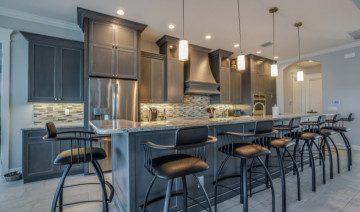
Kitchen Lighting
Overall, kitchens need at least two or more watts from incandescent bulbs, or 1.7 fluorescent or halogen watts, per square foot.
Although track lights work well for accent lighting, they are usually a poor choice for ambient and task lighting in a kitchen because they are difficult to place without creating shadows, and unless they can be placed between exposed ceiling joists, they will leave the upper reaches of the room in shadow.
RECESSED FIXTURES
Some recessed fixtures, especially the high wattage ones, cannot be placed next to insulation. Unless the light is rated “IC” (insulated ceiling) or equivalent, all insulation must be removed from the area determined by the requirements of that specific fixture.
Figure: Lighting Coverage of Recessed Fixtures

Note: These coverage figures are based on providing 15 to 25 footcandles of light. Darker rooms require higher wattage, and spacing will vary with the distance from fixture to subject.
Match bulb to trim. Recessed fixtures typically accept PAR “R” lamps, as well as standard “A-lamp” incandescent bulbs. The trim, as well as the bulb, determines the light output of the fixture (above). Using the wrong bulb in a recessed fixture can result in ineffective, wasteful lighting. Advise clients about the correct bulbs to use with recessed fixtures (below).
Figure: Bulbs and Trims for Recessed Fixtures

Off-the-shelf recessed cans commonly come with a black or white baffle designed to be used with a PAR bulb (top left). A less expensive A-bulb will be ineffective with this trim (bottom left). For clients who plan to use A-bulbs, use a deep parabolic reflector (right), which directs most of the light out of the can.
Black step baffle trim absorbs about 50% of the light generated by the lamps, greatly reducing their efficiency. Black trim also contrasts with the typical white ceiling and draws the eye upward.
Instead, use white trim, mirrored Alzak, or clear specular reflectors. White trim still absorbs about 30% of the light, while Alzak allows virtually all the light to exit the can. Also, the mirrored surface reflects the color of the ceiling, causing it to “disappear” better than white trim.
UNDERCABINET LIGHTING
Undercabinet lighting provides the bulk of task lighting in a kitchen. Mount fixtures as close as possible to the front face of the wall cabinet (below). A 2-in. recess in upper cabinets will make it easier to conceal the fixture than the standard 11/2-in. recess.
Figure: Undercabinet Lighting

Mount undercabinet fixtures as far forward as possible in the cabinet recess to illuminate the front edge of countertops.
Halogen hockey-puck lights, and xenon or fluorescent strip lights, work best. Separate incandescent lamps are difficult to place under cabinets and generate excess heat that may be undesirable in a kitchen.
Fluorescents used for undercabinet lighting must be rated for contact with combustible surfaces, and have safety sleeves over the tubes to reduce the chance of breakage.
Halogen pucks can be fit into the standard 11/2-in. recess below upper cabinets, and served by a transformer located remotely (usually in one of the cabinets). Shadowless illumination requires many lamps (about one every 18 in.) to provide continuous coverage.
SINK LIGHTING
Undercabinet lighting will not work above a sink unless there is a shelf at upper cabinet height. Above a sink with a window above it, use a pair of adjustable ceiling fixtures, arranged so the beams cross the sink area to reduce glare (below).
Figure: Sink Lighting

To avoid glare, aim fixtures so the beams cross each other.
ISLAND LIGHTING
To provide task lighting for islands or kitchens without wall cabinets, use a series of small (2 or 3 in. in diameter) pendant-fixtures mounted at eye level. It’s a good idea to provide separate switches for these areas so the area can be “de-emphasized” when not in use.
As with an island, the kitchen table may be treated as a task area. Use decorative pendant lights controlled by a dimmer for variable atmosphere.
